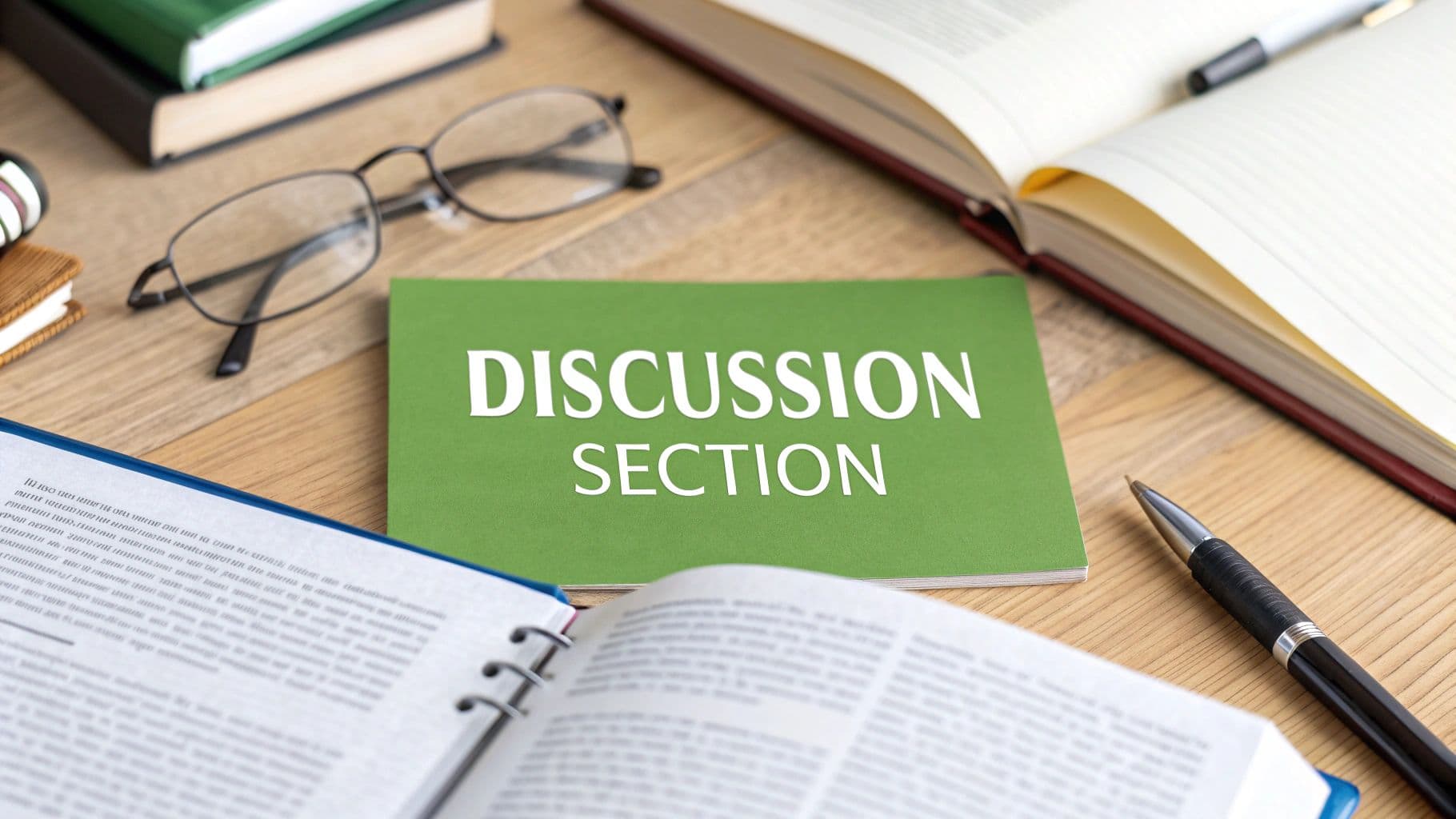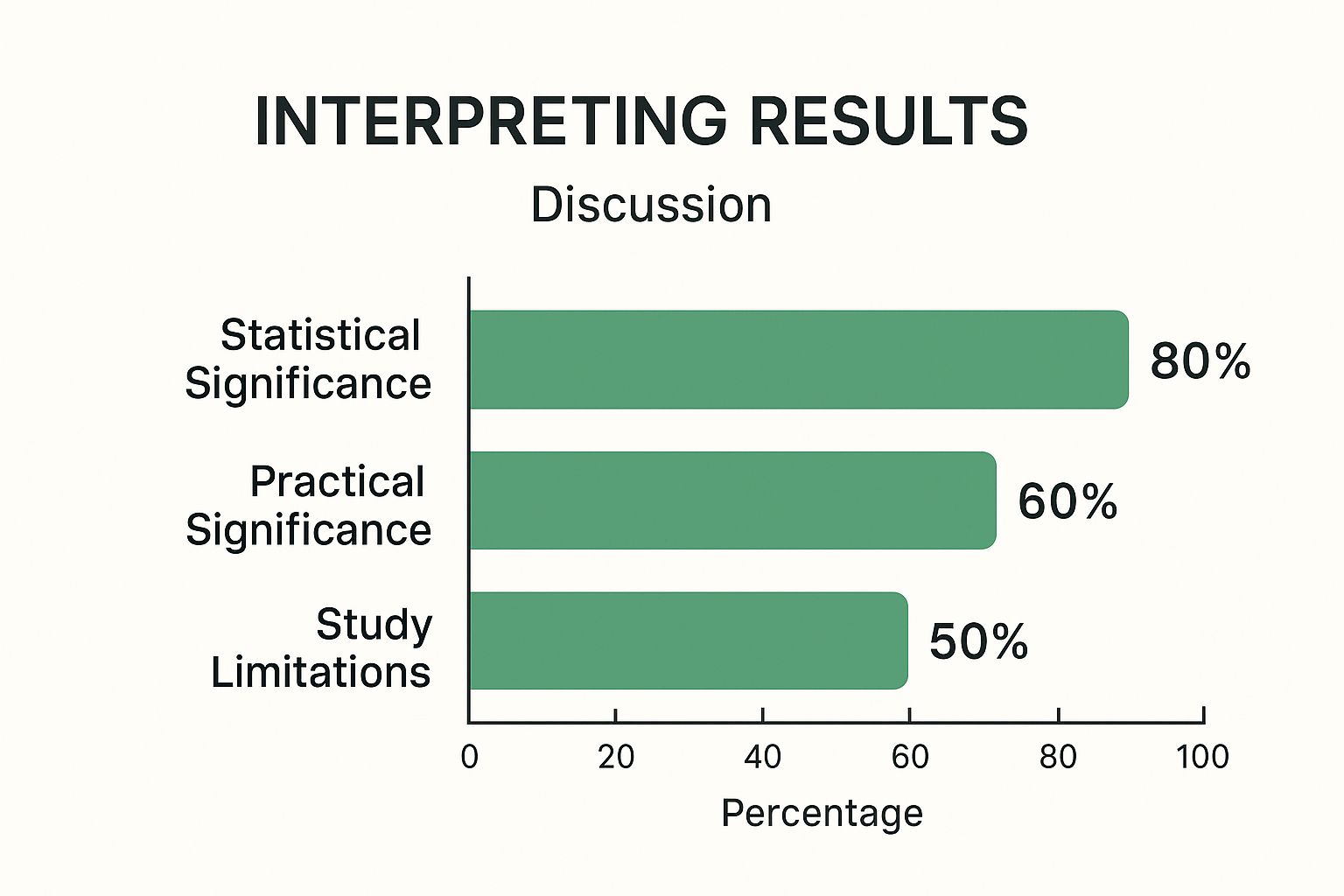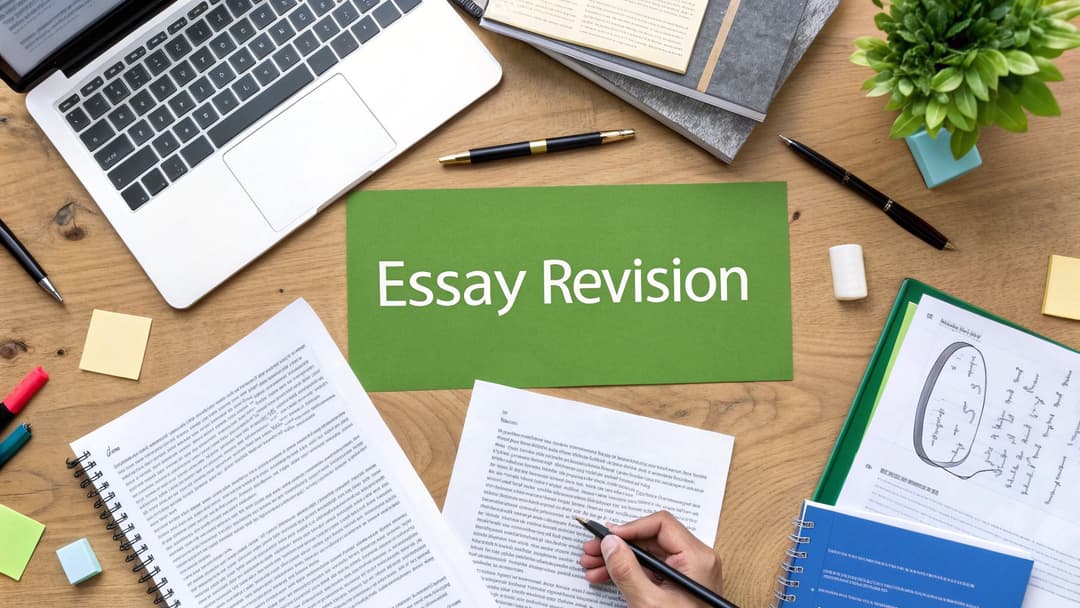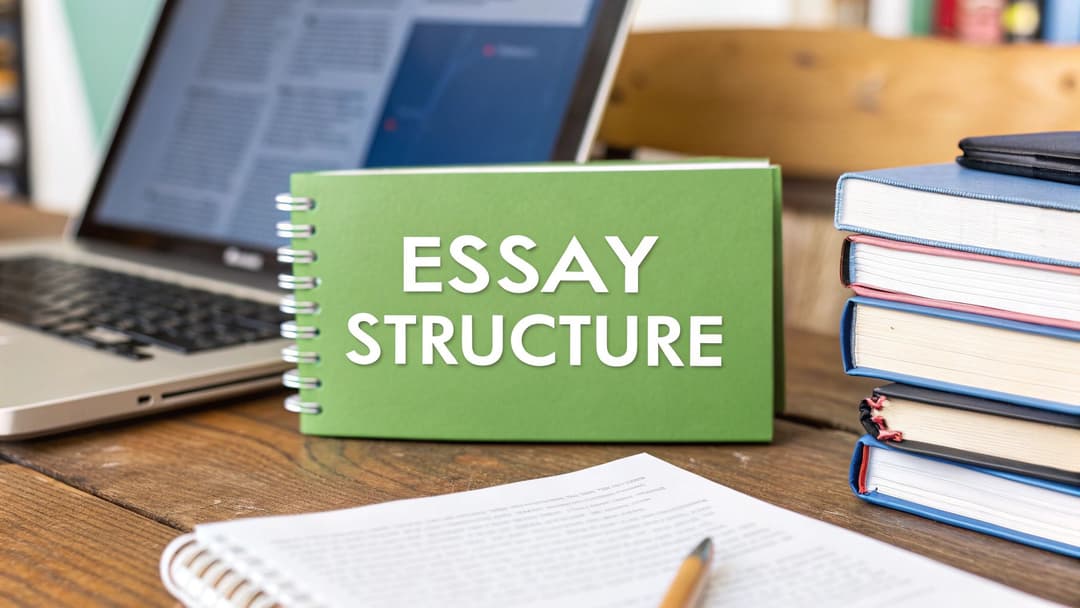
How to Write a Discussion Section: Tips for Your Research Paper
October 2, 2025
So, you’ve run your experiments, crunched the numbers, and written up your methods and results. Now comes the hard part: the discussion section. This is where you have to move beyond just reporting what you found and start explaining why it matters. It’s your chance to transform that raw data into a compelling story that adds to the scientific conversation.
This section is all about analysis, context, and persuasion. You’re not just summarizing; you're interpreting.
The True Purpose of a Discussion Section

It’s easy to think of the discussion as a simple summary of your findings, but its role is much bigger than that. This is your moment to step up and tell the story behind your graphs and tables. Instead of just rehashing the data, your job is to weave your results into the larger body of research in your field.
Think of it as building a bridge. On one side, you have your specific study. On the other, you have the vast landscape of existing knowledge. Your discussion connects the two, showing your readers—whether they're peers, professors, or journal editors—that your work genuinely matters.
Why This Section Is So Challenging
Let's be honest: writing a great discussion is tough. It’s a common hurdle for academics at all levels. In fact, surveys from academic writing coaches show that over 70% of early-career researchers find this part of their paper the most difficult to structure.
The pitfalls are common: failing to put results in context, awkwardly explaining unexpected findings, or forgetting to suggest where research should go next. One analysis of 500 dissertation chapters found that only 55% clearly tied their findings back to the original research question. That’s a fundamental misstep. If you want to dig deeper into these common issues, it's worth reviewing expert advice on writing a compelling discussion section.
The difficulty comes from a necessary shift in mindset. Your Methods and Results sections are mostly descriptive and objective. The Discussion, however, is all about interpretation and argumentation. It requires you to:
- Analyze and Interpret: Go beyond the surface to explain what your findings actually mean.
- Contextualize: Show how your work confirms, challenges, or refines what others have already done.
- Acknowledge Nuance: Address the limitations and any weird, unexpected results with transparency and confidence.
- Propose a Path Forward: Suggest the next logical steps for future research based on what you’ve learned.
The best discussion sections don't just report findings; they build a compelling argument. They guide the reader through a logical progression of ideas, from specific results to broad implications, ultimately proving the study's value.
A Roadmap For Your Discussion
To make this complex process more manageable, it helps to break the discussion down into its core parts. Thinking about these components gives you a clear roadmap, ensuring you hit all the essential points for a high-impact section.
Before we walk through the step-by-step process of writing, let's look at the key pieces that make up a strong discussion. This table serves as a quick blueprint you can refer back to as you start drafting.
Core Components of a Powerful Discussion Section
| Component | Purpose | What to Include |
|---|---|---|
| Opening Statement | Re-state the primary finding and answer the main research question. | A clear, direct summary of your most important result without repeating raw data. |
| Interpretation | Explain the meaning and significance of your findings. | Your analysis of why the results occurred and what they imply. |
| Contextualization | Connect your findings to existing literature and theory. | Comparisons showing how your work confirms, refutes, or adds to previous studies. |
| Limitations | Acknowledge the boundaries and weaknesses of your study. | An honest assessment of methodological or sampling constraints. |
| Implications | Discuss the practical or theoretical impact of your research. | How your findings could influence practice, policy, or future theory. |
| Future Directions | Propose next steps for research in the field. | Specific, actionable research questions that arise from your study. |
With these building blocks in mind, you have a solid structure to guide your writing and ensure you create a discussion that is both thorough and persuasive.
Crafting a Powerful Opening Paragraph

The first paragraph of your discussion is your moment to land the punch. Forget about slowly warming up or rehashing your introduction—you need to make an impact right away. This opening sets the stage for everything that follows, telling your reader that you’re about to deliver the core message of your entire study.
Think of it like this: it’s where you finally answer the "so what?" question that's been hanging in the air since page one. The best way to do that is to hit them with a clear, confident statement summarizing your single most important finding. This isn't the time to list off data points; it’s about weaving them into one powerful takeaway.
Start with the Answer
Your reader just made it through your methods and results. They’re ready for the big reveal, so don’t make them wait. Your very first sentence should directly answer the central question that drove your research.
For example, if your research asked, "Does a new teaching method improve student test scores?" your opening shouldn't be a timid "This study investigated a new teaching method." Go for something decisive: "Our study found that the new cognitive-focused teaching method significantly increased test scores among high school students, suggesting a viable alternative to traditional lecture-based instruction."
This approach instantly satisfies your reader's curiosity and frames the entire discussion. From there, every paragraph can build on this central claim, adding context, interpretation, and nuance. It’s the same principle behind https://naturalwrite.com/blog/strong-topic-sentences-for-body-paragraphs, where you lead with the main idea to guide the reader.
Key Takeaway: Your opening paragraph is a tight synthesis of your most critical result. It’s not a summary of the whole paper or a repeat of the abstract. It's the thesis statement for your discussion section.
What to Avoid in Your Opening
It’s easy to fall into a few common traps here. Knowing what they are can help you sidestep them and write a much stronger opening.
Try to steer clear of these missteps:
- Repeating the Introduction: Don’t restate background info or the literature gap. Your reader just saw all of that.
- Restating Raw Data: Avoid simply copying key stats from your results. Instead of saying, "Group A had a mean score of 85 (SD=2.1) while Group B had a mean of 78 (SD=2.3)," translate it: "Our findings clearly demonstrate the superior efficacy of the intervention in Group A."
- Being Vague or Timid: Ditch phrases like "The results were interesting" or "This paper sought to explore..." Be direct. State what you found with confidence.
Real-World Examples of Strong Openings
Let's see how this looks in practice across a couple of different fields. The principle is always the same, but the language flexes to fit the discipline.
Example 1 (Clinical Psychology)
- Weak Opening: "The purpose of this study was to examine the effects of mindfulness meditation on anxiety levels in college students."
- Strong Opening: "Our randomized controlled trial provides compelling evidence that a brief, eight-week mindfulness meditation program can substantially reduce symptoms of generalized anxiety among college students, offering a scalable mental health intervention for university settings."
Example 2 (Environmental Science)
- Weak Opening: "We collected water samples from various points along the river to measure pollutant levels."
- Strong Opening: "This research reveals a significant and previously undocumented downstream increase in phosphate concentrations directly linked to agricultural runoff, challenging the effectiveness of current water management policies in the region."
Notice how the strong versions immediately establish the importance of the findings. Making a strong first impression is universal. For a different perspective on this, the advice on crafting a powerful opening statement for a debate is surprisingly relevant—the goal of capturing attention and stating a clear position is exactly the same. Your opening paragraph is your academic opening statement. Make it count.
Interpreting and Contextualizing Your Findings
So, you’ve presented your findings. Now comes the hard part—and the most important one. This is where you shift from reporting what you found to explaining what it all means. You’re not just listing data points; you're connecting them to the bigger conversation happening in your field.
Think of it as building a bridge. On one side, you have your isolated results. On the other, you have the vast landscape of existing research. Your job is to show how your work fits in, whether it supports a long-held theory, challenges a common assumption, or adds a surprising new twist.
Moving from Data to Meaning
This is where you connect the dots for your reader. It's not enough to say you found a 15% improvement in Group A. Why does that matter?
Give it context. You could write something like: "The 15% improvement in Group A is especially significant when you consider that most studies in this area report gains of only 5-7%. This suggests our modified protocol might be the driving factor behind this boost."
See the difference? You’ve instantly given that number weight and significance. Your interpretation is your unique contribution—it’s the analysis that only you, the person who did the work, can provide.
The image below shows where researchers tend to focus their energy in the discussion section. Notice the heavy emphasis on just reporting stats versus explaining what they actually mean.

It’s pretty revealing. While most papers hit the statistical points, fewer than two-thirds take the crucial next step of explaining the real-world importance of those findings. That’s a huge missed opportunity.
Engaging with Existing Literature
A strong discussion section shows you know the landscape of your field inside and out. It’s all about comparing your results with what others have found. This is a direct continuation of the work you did when you learned how to write a literature review, but this time, you're bringing your own data to the table.
Here’s how you can frame these comparisons to build a strong narrative:
- To Confirm: "Our findings are right in line with Smith's (2021) work, which also found a strong correlation here. This just adds more weight to the evidence."
- To Extend: "Jones (2019) saw a similar effect, but they were in a controlled lab setting. Our study takes this a step further, showing it holds up in a real-world clinical environment."
- To Contradict: "Interestingly, our results seem to contradict what Doe (2020) found. We suspect this might be because our study population was much broader in age, which could be a key factor."
The biggest mistake I see is when writers just list off who found what. Don't create a catalog. You need to build an argument. Explain why the results are similar or different and what that means for the field.
Sadly, this is a common pitfall. One analysis of thousands of biomedical articles found that only 60% of clinical trials actually bothered to compare their results to existing studies. That’s a critical gap that leaves readers wondering about the novelty and importance of the work.
Responding to Your Research Outcomes
How you frame your discussion really depends on what you found. Expected results are straightforward, but unexpected or inconclusive ones require a bit more finesse. They need to be presented as opportunities, not failures.
This table breaks down how to approach each type of outcome.
| Outcome Type | Interpretation Strategy | Example Phrasing |
|---|---|---|
| Expected | Reinforce the existing theory or hypothesis. Emphasize how your data adds stronger evidence. | "As predicted, our results align with the prevailing theory, providing robust support for..." |
| Unexpected | Acknowledge the surprise directly. Propose alternative explanations or methodological reasons. | "Contrary to our hypothesis, we observed... This might be explained by an alternative mechanism..." |
| Inconclusive | Be transparent about the ambiguity. Discuss potential limitations and suggest directions for future research. | "The data did not yield a clear conclusion on this point, possibly due to... Future studies should..." |
No matter the outcome, the goal is to be honest and analytical. A good discussion turns every result, even a messy one, into a valuable piece of the scientific puzzle.
Handling Unexpected or Contradictory Findings
So, what happens when your results make no sense? When they fly in the face of your hypothesis or everything you’ve read?
First, don't panic. Unexpected findings aren't failures. Honestly, they’re often the starting point for the most exciting discoveries.
Don’t try to bury them. Address them head-on. This is your chance to really show off your critical thinking.
Start by just stating the surprise: "Contrary to our initial hypothesis, we did not observe a significant effect..." Then, dig into the why.
- Was it the method? "This unexpected outcome could be an artifact of our measurement tool, which may not have been sensitive enough to capture subtle changes."
- Is there another theory? "One possible interpretation is that the relationship isn't linear, as we assumed, but follows a U-shaped curve."
- Was your sample unique? "The lack of effect might be tied to our specific population of novice users, suggesting the intervention only works for those with prior experience."
When you frame confusing results as a puzzle to be solved, they stop being a problem and become a genuine contribution. This kind of deep thinking is a crucial skill, and it's something you'll use constantly in academia, especially when it comes to mastering grant writing for research.
Acknowledging Limitations with Confidence
Talking about your study's limitations can feel like you're pointing out all the things you did wrong. But it’s actually the exact opposite. It signals that you're a credible, self-aware researcher who understands the real-world boundaries of your work.
This isn’t about apologizing for your research. It’s about framing it with intellectual honesty, which is how you build serious trust with your readers and, more importantly, with your reviewers.
Every single study has limitations. It's just a fact. Whether it’s a small sample size, a specific demographic, or the type of measurement tool you used, no project can possibly answer everything. Acknowledging these boundaries proves you’ve thought critically about your work and where it fits into the bigger picture.
Frame Limitations as Boundaries, Not Failures
The trick is to present limitations not as mistakes, but as the lines that define your study's scope. You want to explain why a certain choice was made and what its potential impact might be, all without undercutting your core findings.
Being upfront about this stops reviewers from thinking you've just overlooked a potential weakness. It shows you're in control of the narrative.
In fact, one analysis of 1,200 published papers found that discussion sections that addressed both strengths and weaknesses were cited 35% more often. Yet, only about 60% of the articles in that sample even had an explicit limitations paragraph. That’s a huge missed opportunity for a lot of researchers.
Your goal is to show that you've already considered the limitations and that your conclusions are still solid within those boundaries. It’s about being precise, not perfect.
Common Types of Limitations to Look For
When you're figuring out how to write a discussion section, it helps to know what kind of limitations are most relevant. They usually fall into a few key buckets.
- Methodological Limitations: These are all about your research design. Maybe you used a cross-sectional design that can only show correlation, not causation. Or perhaps you relied on a self-report survey, which always comes with a risk of bias.
- Sample Limitations: This is a big one. Your sample might be small, not very diverse, or pulled from a very specific group (like university students). This doesn't kill your findings, but it does mean you need to be careful when talking about how widely they apply.
- Instrument Limitations: The very tools you used to gather data might have their own constraints. A piece of lab equipment could have a known margin of error, or a psychological scale might not capture every single nuance of a complex human emotion.
Turn a Weakness into an Opportunity
The absolute best way to discuss limitations is to immediately follow them up with suggestions for future research. This simple move reframes the whole conversation. You’re no longer just critiquing your own work; you're laying out a roadmap for the entire field.
Here’s how you can spin a limitation into a constructive point that makes you look like a forward-thinking expert.
| Limitation Example | How to Frame It | Suggestion for the Future |
|---|---|---|
| Small Sample Size | "While our findings are compelling, the small sample size limits the generalizability of our results." | "Future work should aim to replicate these findings in a larger, more diverse cohort to confirm their broader applicability." |
| Short Study Duration | "The three-month duration of our study may not capture the long-term effects of the intervention." | "A longitudinal study tracking participants over several years would provide critical insights into the sustainability of these outcomes." |
| Self-Reported Data | "Our reliance on self-reported data introduces the possibility of social desirability bias." | "Subsequent studies could incorporate objective measures, like biometric data, to corroborate these self-reported findings." |
When you take this approach, you're not just listing weaknesses. You're actively guiding the scientific conversation, showing deep expertise, and demonstrating that you're already thinking about the next step. That kind of confident, transparent handling of limitations is what separates a good discussion section from a great one.
Concluding with Impact and Future Directions

The final paragraphs of your discussion are your last chance to make an impression. This isn't just about summarizing what you've already said; it's where you finally answer the "so what?" question that's been hovering over your entire paper.
Your goal here is to pull back from the nitty-gritty details and show your reader the bigger picture. You’ve laid out the evidence and interpreted your findings. Now it's time to deliver a closing argument that cements your paper's contribution to the ongoing conversation in your field.
Answering the Ultimate “So What?”
A great conclusion zooms out. It connects your specific, narrow study to real-world applications or broader theoretical debates. Think of it as explaining how your small piece of the puzzle changes our view of the entire picture.
To nail this, ask yourself a few tough questions:
- Practical Implications: Who can actually use these findings? Could they inform a new policy, change a clinical practice, or help design a better product?
- Theoretical Implications: Does your research support, challenge, or refine an existing theory? Did you stumble upon a new way of thinking about a concept?
- Overall Significance: If a reader walks away remembering only one thing from your study, what should it be?
Answering these questions helps you move from simply restating results to highlighting their importance. For example, instead of a flat "Our study showed the intervention was effective," you could write, "These findings suggest that schools could adopt this low-cost intervention to improve student outcomes, potentially closing critical achievement gaps."
That small shift is everything. For more on this, our guide on how to write a conclusion paragraph has some extra strategies for making your endings stick.
Proposing Future Directions
A strong discussion doesn't just end; it points the way forward. By suggesting specific, actionable directions for future research, you show just how deeply you've engaged with your topic. This isn't an afterthought—it's a sign that you see your work as a starting point for new discoveries, not a final destination.
Steer clear of the generic "more research is needed." Of course it is. That’s why we’re all here. Instead, propose concrete questions that flow directly from your own findings and, just as importantly, your study's limitations.
Key Takeaway: Proposing future research isn't about listing everything that could be studied. It's about identifying the most logical and impactful next steps that build directly on the foundation you've just laid.
Making Your Suggestions Specific and Justified
Your recommendations for what comes next should be precise and well-reasoned. Each one should feel like a natural extension of the story you've just told, grounded in the evidence you've presented.
Here’s a simple framework to give your suggestions some teeth:
- Identify a Gap: Start with a limitation or an unanswered question from your own study. For example: "Our study focused on short-term effects, leaving the long-term impact unknown."
- Propose a Specific Study: Turn that gap into a clear research question. "A longitudinal study tracking participants for five years would be necessary to determine the intervention's durability."
- Explain the Rationale: Justify why this new research matters. "Such a study would be critical for policymakers considering long-term funding for this program."
This structured approach transforms a simple wish list into a compelling research agenda. By pointing the way forward, you’re not just finishing your paper—you’re actively shaping the future of your field.
Your Top Questions About the Discussion Section, Answered
Even with the best outline, you’re bound to hit a few snags when you’re deep in the writing process. Nailing the discussion section often comes down to knowing how to handle these common sticking points. Let's walk through some of the questions I hear most often from researchers and get you some clear, practical answers to keep the momentum going.
How Long Should This Thing Actually Be?
This is probably the number one anxiety, and the honest answer is: it depends. There’s no magic number. A good starting point is to check out high-quality papers in your target journal or recent dissertations from your own department. See what the standard looks like in your field.
As a general guide, a discussion in a typical research paper might land somewhere between 1,000 and 2,000 words. If you're writing a dissertation chapter, you're looking at a much bigger lift, often in the 3,000 to 5,000-word range. But remember, substance beats length every time. The goal is to be thorough enough to interpret your findings, link them to the literature, own up to your limitations, and point the way forward—without rambling or going off on a tangent.
Do I Have to Mention Results That Weren’t Significant?
Yes, you absolutely should. A non-significant result is still a result. It's a part of your research story, and sweeping it under the rug can feel misleading. Tackling these findings head-on shows your integrity as a researcher and proves you’ve thought deeply about your data.
When a result doesn’t hit that p < .05 threshold, especially one that goes against your hypothesis, your job is to play detective. Why did it happen?
- Was it a power issue? Maybe your sample size was just a little too small to pick up on a real, but subtle, effect.
- Was it about the methods? Perhaps the measurement tool you chose wasn't sensitive enough to capture what you were looking for.
- Is it a genuine null effect? It’s entirely possible that the relationship you were hunting for just isn't there. That, in itself, is a valuable piece of knowledge for the field.
Addressing these outcomes directly adds a layer of nuance and credibility that reviewers love to see.
What if My Findings Contradict… Everything?
First off, take a deep breath. This isn't a disaster. In fact, it's often where the most exciting science begins. Findings that buck the trend aren’t a problem to hide; they’re an opportunity to push your field in a new direction. The key is to handle them with a careful, analytical touch.
Start by acknowledging the contradiction directly—no beating around the bush. Then, systematically walk through the possible reasons for the discrepancy. Could it be a difference in methodology? The specific population you studied? The unique context of your experiment? Your role here is to present your findings with confidence while offering well-reasoned hypotheses for why they look different from what’s already out there. This is the kind of critical thinking that separates a good researcher from a great one.
Contradictory findings are not a sign of failure. They are a sign of discovery. Your discussion is the place to explore what that new discovery might mean for your field.
How Honest Should I Be About Limitations?
Completely honest, but also strategic. Acknowledging your study's limitations is a sign of strength, not weakness. It shows you have a clear-eyed view of your work. The trick is to frame them constructively, not in a way that accidentally torpedoes your entire study.
Don't just create a laundry list of every tiny thing that went wrong. Instead, zero in on the two or three most significant limitations—the ones that have a real impact on how your findings should be interpreted. And here's the most important part: for every limitation you raise, suggest how future research could overcome it. This simple move transforms a weakness into a forward-thinking recommendation and positions you as a thoughtful leader in the conversation.
Can I Bring in New References Here?
Yes, and you should! Your introduction laid the groundwork with foundational literature, but your discussion is where you need to get specific. To properly contextualize your findings, you'll almost certainly need to bring in new sources that you didn't mention earlier.
This is a totally natural and necessary part of building your argument. It shows you’re engaging with the most current and relevant work as it relates to your actual results, not just the background theory. Just make sure any new citations are high-quality and directly support the point you’re making.
Crafting a discussion section that feels clear, persuasive, and insightful is a real skill. And as you refine your draft, it’s easy for sentences to come out sounding a bit robotic, especially if you used AI for an assist.
If you want to make sure your final paper has that natural, human touch that sails past AI detection, give Natural Write a try. Our free tool instantly polishes your text, improving its flow and clarity without messing with your core ideas. Give your hard work the humanized finish it deserves at https://naturalwrite.com.


